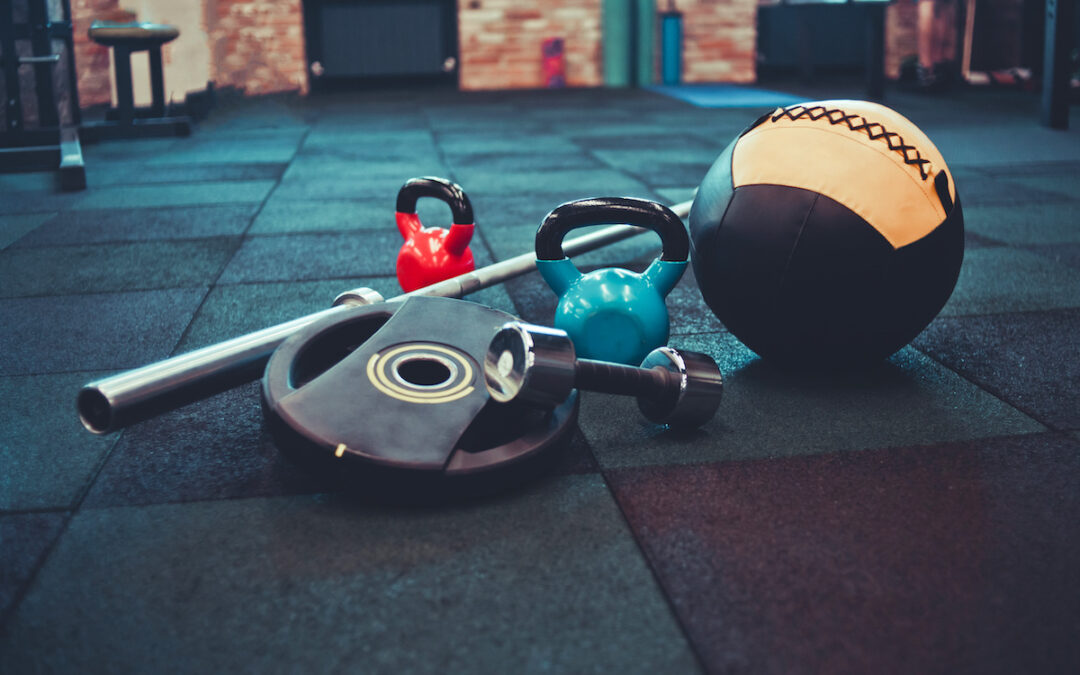What is free-weight strength training and how can it help you? Continue reading and let us begin this “Free Weights Strength Training 101” to give you information on what you need to know about this type of workout.
What is Strength Training?
Strength training is defined as a type of physical exercise that strengthens and tones muscles against resistance. It can be performed anywhere, at a park, at home, or at the gym. It is possible to do it with or without equipment. You can use your own body weight or use external weights to help build overall skeletal muscle mass, strength, and endurance.
Strength training isn’t just for people who want to bulk up for the summer. In fact, it can benefit you whether you are a beginner or an intermediate fitness enthusiast. It can help change your physique, improve your mood, and your body systems, and provide positive mental benefits.
Training with Free Weights
Free weights are a type of strength training that can be defined as resistance exercises provided by “free” weights/objects. In this case, the weights are not attached to anything and can be picked up and moved.
The main types of free weights are dumbbells, barbells, weight plates, medicine balls, kettlebells, and sandbells.
Benefits of Strength Training with Free Weights
Working out with free weights has countless benefits. Free weights will provide you with more benefits than just working out with machines or your body weight.
Physical and Mental Health
Strength training with free weights, like any other exercise, can help you improve not only your physical fitness but also your mental fitness. Aside from helping you build strong and lean muscles, these exercises also aid in the reduction of symptoms of certain mental illnesses such as anxiety and depression.
Multi-Muscle Involvement
Free-weight exercises improve your overall coordination while targeting your larger and more superficial muscles while also taxing your smaller stabilizing muscles. It works multiple muscles at the same time, which is very similar to how we function in reality.
Athleticism
If you intend to participate in sports in the near future, these strength training workouts are a good place to start in order to prepare yourself. It will help you improve your coordination and your unilateral strength, which are beneficial in a competitive environment. The greater your base of strength, the greater your potential for athleticism.
Functional Strength
Using free weights is an excellent way to develop functional strength. It is a type of strength that mimics both sports-specific and real-life activities that require a wide range of motion. These exercises not only improve the strength and endurance of all the muscles involved but also aid in the development of cardiovascular endurance. It also promotes better overall mobility.
Flexibility and Versatility
In general, strength training can also improve your versatility. Strength training improves joint range of motion (ROM), resulting in increased mobility and flexibility. Increased stability, flexibility, and mobility allow athletes and fitness enthusiasts to use strength training strategies and reach their full range of motion, allowing target muscles to burn and strength to be boosted
Stronger Bones
Strength training increases bone density and lowers the risk of fractures. Loading your bones with weight-bearing exercise causes a response that stimulates bone cells to build more, resulting in increased bone strength.
Types of Training Routines
Core Training Routines
Core-strengthening exercises strengthen your core muscles, which include your abdominal muscles, back muscles, and pelvic muscles. These strengthening exercises will improve your balance, stability, posture, overall strength, speed, and agility.
Push Training Routines
This type of workout not only provides a highly efficient method of weight lifting and resistance training, but it also allows you to spend less time at the gym and recover faster. Push exercises for the upper and lower body involve pushing something away from yourself. A good push-day routine should include exercises that target your chest, shoulders, and triceps, such as dumbbell shoulder presses and side lateral raises.
Pull Training Routines
Pull exercises are movements in which you pull a weight toward your body. The biceps, hamstrings, glutes, and back muscles are primarily used in these exercises. Some effective pull exercises include deadlifts, dumbbell shrugs, barbell rows, pullovers, and barbell bicep curls.
Leg Training Routines
Stretch and strengthen your leg muscles to make daily activities like walking and climbing stairs safer and easier. Russian kettlebell swing, barbell deadlift, and weighted glute bridge are all effective leg exercises.

Free-Weight Exercises
There are a variety of strength training workouts that you can do at home or at your favorite gym. Here’s a list of free weight exercises that you can try anywhere:
a. One Arm Swing
b. Goblet Squat
c. Diamond Press-Up
d. Biceps Curl
e. Dumbbell Shoulder Press
At the Gym
a. Romanian Deadlift
b. Overhead Press
c. Barbell Lunge
d. Shoulder Press
e. Back Squat
Creating a Free Weight Training Plan
Planning
Planning ahead of time is the best way to achieve your fitness goals. A good weight training program can assist you with focusing on your workouts and achieving your goals. A well-planned workout will yield positive results and make your fitness goals attainable.
Developing a fitness plan eliminates the risk of falling into procrastination or the “Mañana Habit” attitude and holds you accountable for the daily plan. Planning will help to keep you motivated all throughout your fitness journey.
Workout plans have numerous advantages. They can inspire you, teach you new skills, and make the whole process of getting regular exercise easier. If your plan has been properly put together, you should be getting the most out of your workouts, which is especially important if you want to achieve your goals in a short amount of time.
Scheduling
It’s critical to be honest about how much time you’re willing or able to devote to weight training each week. Setting a plan with a short-term goal is a good place to start. When you get close to the end of that, you can evaluate your progress and make plans for the next eight weeks. Your weight training program is unique to you, so scheduling it the proper way and according to your needs and preferences will go a long way.
Executing
A plan without execution is meaningless and ineffective. So, after careful planning and scheduling of proper exercise routines to achieve your fitness goals, the next significant step is to begin the specific regimen.
Resting
Don’t go overboard with anything. After a strenuous workout, make sure you give yourself enough time to sleep and rest. Remember that muscle is gained not through training but by allowing your muscles to rest and recover.
Monitoring
Monitoring your progress throughout your fitness journey will allow you to see your progress. This is also the most effective way to motivate yourself, particularly if you notice a significant improvement in your physical condition. Monitoring helps you to make changes to your plan in case you’re not moving along.
It is also advisable to keep an eye out for any pain or discomfort while working towards your fitness goals. If you notice anything out of the ordinary, stop, reassess yourself, take a break, and consult a doctor if necessary.
Key Takeaway
Strength training, also known as weight training or resistance training, is an essential component of any fitness regimen. When working with heavy free weights, it is critical to warm up before beginning your session. Not only will you reduce your risk of injury, but you’ll also ensure that you’re ready to excel from the first rep onward, rather than struggling through your first few sets as your body adjusts to the idea of working out.
Although staying active and participating in physical activity is important for our overall health and mental well-being, it’s also important to give our bodies the time they need to rest and recover. Over-exercising, whether it’s cardio or free weights, can put additional strain and stress on our bodies and can then result in a variety of negative side effects. Just stay focused on your goal. Enjoy every workout session, and before you know it, you’re already there without even realizing it. Stay healthy and safe!
References:
5 Reasons We Prefer Free Weights for Strength Training
How to Plan a Weight Training Program
Author Bio
Rachel Miller is a certified Sport and Fitness Enthusiast who loves to write about her
passion for Nordic Lifting. Her Fitness goal is to spread awareness and instill in the lives of people everywhere the value of health and fitness.



